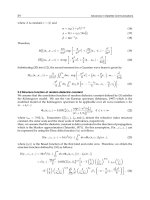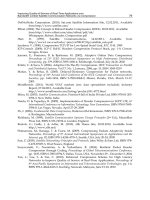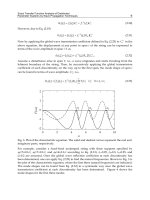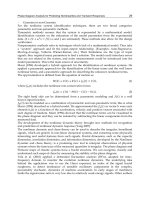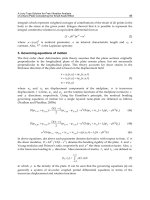Recent Advances in Vibrations Analysis Part 4 pdf
Bạn đang xem bản rút gọn của tài liệu. Xem và tải ngay bản đầy đủ của tài liệu tại đây (321.04 KB, 20 trang )
A Levy Type Solution for Free Vibration Analysis
of a Nano-Plate Considering the Small Scale Effect
49
integrals which represent weighted averages of contributions of the strain of all points in the
body to the stress at the given point. Eringen showed that it is possible to represent the
integral constitutive relation in an equivalent differential form as
2
(1 )
nl l
(2)
where
2
0
()ea
is nonlocal parameter, a an internal characteristic length and
0
e a
constant. Also,
2
is the Laplacian operator.
3. Governing equations of motion
The first order shear deformation plate theory assumes that the plane sections originally
perpendicular to the longitudinal plane of the plate remain plane, but not necessarily
perpendicular to the longitudinal plane. This theory accounts for shear strains in the
thickness direction of the plate and is based on the displacement field
0
0
(,) (,,)
(,) (,,)
(,)
x
y
uuxy z xyt
vvxy z xyt
wwxy
(3)
where
0
u and
0
v are displacement components of the midplane, w is transverse
displacement,
t is time,
x
and
y
are the rotation functions of the midplane normal to x
and
y directions, respectively. Using the Hamilton’s principle, the nonlocal bending
governing equations of motion for a single layered nano-plate are obtained as follows
(Pradhan and Phadikar, 2009a)
22
,, ,, ,2
(1 )
()()()()
2
xxx
y
x
y
x
yy y
x
y
xx x x
D
DGhwI
(4a)
22
,, ,, ,2
(1 )
()()()()
2
yyy
xx
yy
xx x x
yyyyy
D
DGhwI
(4b)
22
,,,, 1
()(,,)()
x x y y xx yy
Gh w w q x y t I w w
(4c)
In above equations, dot above each parameter denotes derivative with respect to time,
G is
the shear modulus,
DEh
32
/12(1 )
denotes the bending rigidity of the plate, E and
Young modulus and Poisson’s ratio, respectively and
2
the shear correction factor. Also, q
is the transverse loading in
z
direction. Mass moments of inertia,
1
I and
2
I , are defined as
/2
12
/2
(,) (1,)
h
h
II zdz
(5)
in which
is the density of the plate. It can be seen that the governing equations (4) are
generally a system of six-order coupled partial differential equations in terms of the
transverse displacement and rotation functions.
Recent Advances in Vibrations Analysis
50
4. Solution
In order to solve the governing equations of motion (4) for various boundary conditions, it is
reasonable to find a method to decouple these equations. Let us introduce two new
functions
and
as
,,xx
yy
(6a)
x
yy
x,,
(6b)
Using relations (6), the governing equations (4) can be rewritten as
x
y
xx x x
D
DGhwI
22
,, ,2
(1 )
()( )
2
(7a)
y
x
yy y y
D
DGhwI
22
,, ,2
(1 )
()( )
2
(7b)
22 2
1
()( )Gh w
q
Iw w
(7c)
Doing some algebraic operations on Eqs. (7), the three coupled partial differential equations
(4) can be replaced by the following two uncoupled equations
CGhI
22 2
2
(1 )
(8a)
22 2 2 2
1
122
22
22
212
2
(1 ){ ( ) }
(1 )
{}
DID
Dw q qIw IwI
Gh Gh
Iq IIw
Gh
(8b)
where
C denotes
(1 )/2D
. It can be seen that the above equations are converted to the
classical equations of the Mindlin plate theory when
0
. Like the classical elasticity
(Reissner, 1985), Eqs. (8a) and (8b) are called edge-zone (boundary layer) and interior
equations, respectively. Also, the rotation functions
x
and
y
can be defined in terms of
w and
as
xx
DID
Gh I q w D w Ghw
x
Gh Gh
I
IqwwCI
y
Gh Gh
22
2 22
1
2
22
22
2
1
22
22
(1 ) (1 )
[
(1 ) (1 )
()][]
(9a)
yy
DID
Gh I q w D w Ghw
y
Gh Gh
I
IqwwCI
x
Gh Gh
22
2 22
1
2
22
22
2
1
22
22
(1 ) (1 )
[
(1 ) (1 )
()][]
(9a)
A Levy Type Solution for Free Vibration Analysis
of a Nano-Plate Considering the Small Scale Effect
51
By obtaining transverse displacement and rotation functions ( w ,
x
and
y
), the stress
components of the nano-plate can be computed by using the nonlocal constitutive relations
in the following forms
2
,,
2
()
1
nl nl
xx xx x x y y
E
z
2
,,
()
2(1 )
nl nl
xy xy x y y x
E
z
2
,,
2
()
1
nl nl
yy yy y y x x
E
z
2
,
()
nl nl
xz xz x x
Gw
(10)
2
,
()
nl nl
y
z
y
z
yy
Gw
Here, a rectangular plate
()ab
with two opposite simply supported edges at 0x and
xa and arbitrary boundary conditions at two other edges is considered. For free
harmonic vibration of the plate, the transverse loading
q
is put equal to zero and the
transverse deflection
w and boundary layer function
are assumed as
1
()sin( )
n
it
nn
n
wwy xe
(11a)
n
it
nn
n
y
xe
1
( )cos( )
(11b)
which exactly satisfy the simply supported boundary conditions at 0
x
and xa . In these
relations,
n
is the natural frequency of the nano-plate and
n
denotes /na
. Substituting
the proposed series solutions (11) into decoupled Eqs. (8), yields
42
123
42
() ()
() 0
nn
n
wy wy
wy
yy
(12a)
n
n
y
y
y
2
45
2
()
() 0
(12b)
where the constant coefficients
(1, ,5)
i
i
are material constants. The above equations are
two ordinary differential equations with total order of six. The solutions of Eqs. (12) can be
expressed as
11 2 1 3 2 4 2
( ) sin( ) cos( ) sinh( ) cosh( )
n
wy C y C y C y C y
(13a)
n
y
CyCy
536 3
( ) sinh( ) cosh( )
(13b)
where
(1, ,6)
i
Ci
are constants of integration and parameters
1
,
2
and
3
are defined
as
2
22 13
1
1
4
2
(14a)
Recent Advances in Vibrations Analysis
52
2
22 13
2
1
4
2
(14b)
45
3
4
(14c)
Six independent linear equations must be written among the integration constants to solve
the free vibration problem. Applying arbitrary boundary conditions along the edges of the
plate at
0y and
y
b
, leads to six algebraic equations. Here, three types of boundary
conditions along the edges of the nano-plate in
y
direction are considered as
Simply supported (
S) 0
yy x
wM
(14a)
Clamped (
C)0
xy
w
(14b)
Free (F)
0
yy xy y
MMQ
(14c)
where the resultant moments
yy
M
and
x
y
M
and resultant force
y
Q are expressed as
/2
/2
h
nl
yy yy
h
M
zdz
/2
/2
h
nl
xy xy
h
M
zdz
/2
/2
h
nl
yyz
h
Qdz
(15)
In order to find the natural frequencies of the nano-plate, the various boundary conditions
at
0y and yb
should be imposed. Applying these conditions and setting the
determinant of the six order coefficient matrix equal to zero, the natural frequencies of the
nano-plate are evaluated.
5. Numerical results and discussion
For numerical results, the following material properties are used throughout the
investigation
1.2E TPa ,
0.3
,
2
5/6
(16)
In order to verify the accuracy of the present formulations, a comparison has been carried
out with the results given by Pradhan and Phadikar (2009a) for an all edges simply
supported nano-plate. To this end, a four edges simply supported nano-plate is considered.
The non-dimensional natural frequency parameter
24
1
/aID
is listed in Table 1 for
some nonlocal parameters. From this table, it can be found that the present results are in
good agreement with the results in literature when the rotary inertia terms have been
neglected. It can be also seen that the rotary inertia terms have considerable effects
especially in second mode of vibration and cause the natural frequency decreases. Hereafter,
the rotary inertia terms are considered in numerical results.
A Levy Type Solution for Free Vibration Analysis
of a Nano-Plate Considering the Small Scale Effect
53
To study the effects of boundary condition, the nonlocal parameter ()
and thickness to
length ratio
(/)ha on the vibrational behavior of the nano-plate, the first two non-
dimensional frequencies are obtained for a single layered nano-plate. The results are tabulated
in Tables 2-6 for five possible boundary conditions at
0y
and
y
b
as clamped- clamped
(
C-C), clamped-simply (C-S), clamped-free (C-F), simply-free (S-F) and free-free (F-F).
/hb
Mode 1 Mode 2
1nm
0.1
Present
0.1322
0.1332
a
0.1994
0.2026
a
Pradhan (2009a) 0.1332 0.2026
0.2
Present
0.1210
0.1236
a
0.1673
0.1730
a
Pradhan (2009a) 0.1236 0.1730
2nm
0.1
Present
0.0935
0.0942
a
0.1410
0.1432
a
Pradhan (2009a) 0.0942 0.1432
0.2
Present
0.0855
0.0874
a
0.1183
0.1224
a
Pradhan (2009a) 0.0874 0.1224
3nm
0.1
Present
0.0763
0.0769
a
0.1151
0.1170
a
Pradhan (2009a) 0.0769 0.1170
0.2
Present
0.0698
0.0714
a
0.0966
0.0999
a
Pradhan (2009a) 0.0714 0.0999
4nm
0.1
Present
0.0661
0.0666
a
0.0997
0.1013
a
Pradhan (2009a) 0.0666 0.1013
0.2
Present
0.0605
0.0618
a
0.0836
0.0865
a
Pradhan (2009a) 0.0618 0.0865
Table 1. Comparison of non-dimensional frequency parameter
24
1
/aID
of a nano-
plate with all edges simply supported (
a
Neglecting the rotary inertia terms)
Based on the results in these tables, it can be concluded that for constant
/ha
, the
frequency parameter decreases for all modes as the nonlocal parameter
increases. The
reason is that with increasing the nonlocal parameter, the stiffness of the nano-plate
decreases. i.e. small scale effect makes the nano-plate more flexible as the nonlocal model
may be viewed as atoms linked by elastic springs while the local continuum model assumes
the spring constant to take on an infinite value. In sum, the nonlocal plate theory should be
used if one needs accurate predictions of natural frequencies of nano-plates.
Recent Advances in Vibrations Analysis
54
/hb
Mode 1 Mode 2
1nm
0.1 0.1757 0.2124
0.2 0.1494 0.1735
2nm
0.1 0.1242 0.1502
0.2 0.1057 0.1227
3nm
0.1 0.1014 0.1226
0.2 0.0863 0.1002
4nm
0.1 0.0878 0.1062
0.2 0.0747 0.0868
Table 2. First two non-dimensional frequency parameters
24
1
/aID
of a C-C nano-
plate
/hb
Mode 1 Mode 2
1nm
0.1 0.1501 0.2049
0.2 0.1333 0.1700
2nm
0.1 0.1062 0.1449
0.2 0.0942 0.1202
3nm
0.1 0.0867 0.1183
0.2 0.0769 0.0982
4nm
0.1 0.0751 0.1024
0.2 0.0666 0.0850
Table 3. First two non-dimensional frequency parameters
24
1
/aID
of a C-S nano-
plate
/hb
Mode 1 Mode 2
1nm
0.1 0.1273 0.1921
0.2 0.1172 0.1615
2nm
0.1 0.0900 0.1358
0.2 0.0829 0.1142
3nm
0.1 0.0735 0.1109
0.2 0.0677 0.0933
4nm
0.1 0.0636 0.0960
0.2 0.0586 0.0808
Table 4. First two non-dimensional frequency parameters
24
1
/aID
of a C-F nano-
plate
The influence of thickness-length ratio on the frequency parameter can also be examined by
keeping the nonlocal parameter constant while varying the thickness to length ratio. It can
be easily observed that as /ha increases, the frequency parameter decreases. The decrease
in the frequency parameter is due to effects of the shear deformation, rotary inertia and use
of term
2
ah in the definition of the non-dimensional frequency
. These effects are more
considerable in the second mode than in the first modes.
A Levy Type Solution for Free Vibration Analysis
of a Nano-Plate Considering the Small Scale Effect
55
/hb
Mode 1 Mode 2
1nm
0.1 0.1136 0.1753
0.2 0.1070 0.1531
2nm
0.1 0.0804 0.1239
0.2 0.0756 0.1083
3nm
0.1 0.0656 0.1012
0.2 0.0618 0.0884
4nm
0.1 0.0568 0.0876
0.2 0.0535 0.0766
Table 5. First two non-dimensional frequency parameters
24
1
/aID
of a S-F nano-
plate
/hb
Mode 1 Mode 2
1nm
0.1 0.1012 0.1542
0.2 0.0964 0.1401
2nm
0.1 0.0715 0.1090
0.2 0.0682 0.0991
3nm
0.1 0.0582 0.0890
0.2 0.0557 0.0809
4nm
0.1 0.0506 0.0771
0.2 0.0481 0.0701
Table 6. First two non-dimensional frequency parameters
24
1
/aID
of a F-F nano-
plate
To study the effect of the boundary conditions on the vibration characteristic of the nano-
plate, the frequency parameters listed in a specific row of tables 1-6 may be selected from
each table. It can be seen that the lowest and highest values of frequency parameters
correspond to
F-F and C-C edges, respectively. Thus like the classical plate, more constrains
at the edges increases the stiffness of the nano-plate which results in increasing the
frequency.
The effect of variation of aspect ratio
(/)ba on the natural frequency of a C-S nano-plate
is shown in Fig. 1 for various nonlocal parameters. It can be seen with increasing the
aspect ratio, the natural frequency of the nano-plate decreases because of decreasing of
stiffness.
In Fig. 2, the relation between natural frequency and nonlocal parameter of a square C-C
nano-plate is depicted for different thickness to length ratios. It can be seen that nonlocal
theories predict smaller values of natural frequencies than local theories especially for
higher thickness to length ratios. Thus the local theories, in which the small length scale
effect between the individual carbon atoms is neglected, overestimate the natural
frequencies. The effect of boundary conditions on the natural frequency of a nano-plate is
shown in Fig. 3. It can be concluded that the boundary condition has significant effect on the
vibrational characteristic of the nano-plates.
Recent Advances in Vibrations Analysis
56
b/a
×10
-9
1 1.5 2 2.5 3 3.5
3
4
5
6
7
8
9
10
=1 10
-9
=2 10
-9
=3 10
-9
×
××
×
Fig. 1. Variation of natural frequency with respect to aspect ratio for a
C-S nano-plate
×10
-9
0.5 1 1.5 2 2.5 3 3.5 4
2
4
6
8
10
12
14
16
18
20
h/b=0.2
h/b=0.15
h/b=0.1
Fig. 2. Variation of natural frequency with nonlocal parameter for a
C-C nano-plate
A Levy Type Solution for Free Vibration Analysis
of a Nano-Plate Considering the Small Scale Effect
57
×10
-9
0.5 1 1.5 2 2.5 3 3.5 4
1
2
3
4
5
6
7
8
9
C-C
C-S
S-S
C-F
S-F
F-F
Fig. 3. Variation of natural frequency with nonlocal parameter for nano-plates with different
boundary conditions at two edges
6. Conclusion
Presented herein is a variational derivation of the governing equations and boundary
conditions for the free vibration of nano-plates based on Eringen’s nonlocal elasticity and
first order shear deformation plate theory. This nonlocal plate theory accounts for small
scale effect, transverse shear deformation and rotary inertia which become significant when
dealing with nano-plates. Coupled partial differential equations have been reformulated
and the generalized Levy type solution has been presented for free vibration analysis of a
nano-plate considering the small scale effect. The accurate natural frequencies of nano-plates
have been tabulated for various nonlocal parameters, some thickness to length ratios and
different boundary conditions. The effects of boundary conditions, variation of nonlocal
parameter, thickness to length and aspect ratios on the frequency values of a nano-plate
have been examined and discussed.
7. Acknowledgements
The authors wish to thank Iran Nanotechnology Initiative Council for its financial support.
8. References
Aghababaei R. & Reddy J.N. (2009). Nonlocal third-order shear deformation plate theory
with application to bending and vibration of plates. Journal of Sound and Vibration,
Vol. 326, pp. 277–289.
Recent Advances in Vibrations Analysis
58
Ansari R.; Rajabiehfard R. & Arash B. (2010) Nonlocal finite element model for vibrations of
embedded multi-layered graphene sheets. Computational Materials Science, Vol. 49,
pp. 831–838.
Behfar K. & Naghdabadi R. (2005). Nanoscale vibrational analysis of a multi-layered
grapheme sheet embedded in an elastic medium. Composites Science and Technology,
Vol. 65, pp. 1159–1164.
Duan W.H. & Wang C.M. (2007). Exact solutions for axisymmetric bending of
micro/nanoscale circular plates based on nonlocal plate theory. Nanotechnology,
Vol. 18, 385704.
Eringen C. (1983). On differential equations of nonlocal elasticity and solutions of screw
dislocation and surface waves. Journal of Applied Physics, Vol. 54, pp. 4703-4710
He X.Q.; Kitipornchai S. & Liew K.M. (2005). Resonance analysis of multi-layered grapheme
sheets used as nano scale resonators. Nanotechnology, Vol. 16, pp. 2086–2091.
Jomehzadeh E. & Saidi A. R. (2011a) Decoupling the Nonlocal Elasticity Equations for Three
Dimensional Vibration Analysis of Nanoplates. Composite Structures, Vol. 93, pp.
1015-1020.
Jomehzadeh E. & Saidi A. R. (2011b) A study on large amplitude vibration of multilayered
graphene sheets. Computational Materials Science, Vol. 50, pp. 1043-1051.
Jomehzadeh E. & Saidi A. R. (2011c) Study of small scale effect on nonlinear vibration of
nano-plates. Journal of Computational and Theoretical Nanoscience, Accepted.
Kitipornchai S.; He X.Q.; & Liew K.M. (2005). Continuum model for the vibration of
multilayered graphene sheets. Physical Review B, Vol. 72, 075443 6 pages.
Li X.F. & Wang B.L. (2009). Vibrational modes of Timoshenko beams at small scales. Applied
Physics Letters, Vol. 94, 1.3094130.
Lu P.; Zhang P.Q.; Lee H.P.; Wang C.M. & Reddy J.N. (2007). Non-local elastic plate
theories. Mathematical Physical and Engineering Sciences, Vol. 463 pp. 3225-3240.
Murmu T. & Pradhan S.C. (2009a). Small-scale effect on the vibration of nonuniform nano
cantilever based on nonlocal elasticity theory. Physica E, Vol. 41, Vol. 1451–1456.
Murmu T. & Pradhan S.C. (2009b). Small-scale effect on the free in-plane vibration of
nanoplates by nonlocal continuum model. Physica E, Vol. 41, pp. 1628–1633.
Pradhan S.C. & Phadikar J.K. (2009a). Nonlocal elasticity theory for vibration of nanoplates.
Journal of Sound and Vibration, Vol. 325, pp. 206–223.
Pradhan S.C. & Phadikar J.K. (2009b). Small scale effect on vibration of embedded
multilayered graphene sheets based on nonlocal continuum models. Physics Letters
A, Vol. 373, pp. 1062–1069.
Pradhan S.C. & Kumar A. (2010) Vibration analysis of orthotropic graphene sheets
embedded in Pasternak elastic medium using nonlocal elasticity theory and
differential quadrature method. Computational Materials Science, Vol. 50, pp. 239-
245.
Reissner E. (1985). Reflections on the theory of elastic plates. Applied Mechanics Review, Vol.
38, pp. 1453-1464.
Sharma P.; Ganti S. & Bhate N. (2003). Effect of surfaces on the size-dependent elastic state
of nano-inhomogeneities.
Applied Physics Letters, Vol. 82, pp. 535-537
Wang Q. & Liew K.M. (2007). Application of nonlocal continuum mechanics to static
analysis of micro- and nano-structures. Physics Letters A, Vol. 363, pp. 236–242.
4
Second Order Shear Deformation Theory
(SSDT) for Free Vibration Analysis on a
Functionally Graded Quadrangle Plate
A. Shahrjerdi
1
and F. Mustapha
2
1
Department of Mechanical Engineering, Malayer University, Malayer,
2
Department of Aerospace Engineering, Universiti Putra Malaysia,
43400 UPM, Serdang, Selangor
1
Iran
2
Malaysia
1. Introduction
Studies of vibration of plates have matured and are a well-established branch of research in
structural dynamics. They have a vast range of applications in engineering and technology. But
not much work can be found on vibration analysis of Functionally Graded Materials (FGMs) as
compared to isotropic and composite plates and shells. FGMs are those in which the volume
fraction of the two or more constituent materials is varied, as a power-law distribution,
continuously as a function of position along certain dimension(s) of the structure [1, 2].
From the perspective of finite element method (FEM) studies of FGM, Praveen and Reddy
[3], studied the static and dynamic responses of functionally graded (FG) ceramic-metal
plate accounting for the transverse shear deformation, rotary inertia and moderately large
rotations in the Von-Karman sense, in which the effect of an imposed temperature field on
the response of the FG plate was discussed in detail. Ng et al. [4] dealt with the parametric
resonance of FG rectangular plates under harmonic in-plane loading. Ferreira and Batra [5]
provided a global collocation method for natural frequencies of FG plates by a meshless
method with first order shear deformation theory (FSDT). Woo et al. [6] presented an
analytical solution for the nonlinear free vibration behavior of FGM plates, where the
fundamental equations were obtained using the Von-Karman theory for large transverse
deflection, and the solution was based in terms of mixed Fourier series. Zhao et al. [7]
studied the free vibration analysis of metal and ceramic FG plates using the element-free kp-
Ritz method. The FSDT was employed to account for the transverse shear strain and rotary
inertia, mesh-free kernel particle functions were used to approximate the two-dimensional
displacement fields and the eigen-equation was obtained by applying the Ritz procedure to
the energy functional of the system. Batra and Jin [8] used the FSDT coupled with the FEM
to study the free vibrations of an FG anisotropic rectangular plate with various edge
conditions. Also, Batra and Aimmanee [9] studied a higher order shear and normal
deformable plate theory by FEM. Many studies conducted on FGMs are related to the
analysis of free vibration by applying FSDT (see [10-12] and the references there in).
Other forms of shear deformation theory, such as the third order-shear deformation theory
(TSDT) that accounts for the transverse effects, have been considered. Cheng and Batra [13]
Recent Advances in Vibrations Analysis
60
applied Reddy's third order plate theory to study buckling and steady state vibrations of a
simply supported FG isotropic polygonal plate [14]. Vel and Batra [14] dealt with the three-
dimensional exact solution for free and forced vibrations of simply supported FGM
rectangular plates using FDST and TSDT by employing the power series method. Nonlinear
vibration and dynamic response of FGM plates in thermal environments were studied by
Huang et al. [15] based on the higher-order shear deformation plate theory and general Von-
Karman type equation. Static analysis of FG plates using TSDT and a meshless method were
also presented by Ferreira et al. [16].
As for the first-order shear deformation plate theory (FSDT), the theory extends the kinematics
of the classical plate theory (CPT) by relaxing the normality restriction and allowing for
arbitrary but constant rotation of transverse normals. On the other hand, the second and third
order shear deformation plate theory further relaxes the kinematic hypothesis by removing the
straightness assumption; i.e., the straight normal to the middle plane before deformation may
become cubic curves after deformation. The most significant difference between the classical
and shear deformation theories is the effect of including transverse shear deformation on the
predicted deflections, frequencies, and buckling loads [19].
A unified derivation of various shear-deformation models consists of Kirchhoff-Love type,
Mindlin-Reissner type theory, third order theory, Layer-Wise theory and Exact-Solution.
Librescu et al. [22] studied the correlation between two apparently different higher-order
theories and First order transverse shear deformation theory (FSDT) of anisotropic plates.
The Kirchhoff-Love assumptions were developed by Librescu and Schmidt [23]. The theory
incorporates normal and shear deformation (transverse) as well as the higher-order effects,
and accounts for small strains and moderate rotations of the normal.
For experimental work, shear deformation validation and compared structural theories,
Stoffle [20] measured and simulated vibrations of viscoplastic plates under impulsive
loading and determined how accurately the measured deformations can be calculated by
the chosen constitutive and structural theories. He assumed a first-order shear deformation
shell theory and applied small strains and moderate rotations and viscoplastic laws. He
applied short time measurement techniques to shock tubes in order to record fast loading
processes and plate deformations.
As mentioned above, shear deformation theories have been applied to consider transverse
shear strains and rotation. Axisymmetric bending and stretching of functionally graded
solid circular and annular plates were studied using the second-order shear deformation
plate theory by Saidi and Sahraee [21]. Khdeir and Reddy [17] studied the free vibration of
laminated composite plates using SSDT. Bahtuei and Eslami [18] also investigated the
coupled thermoelastic response of a FG circular cylindrical shell by considering SSDT.
To the authors’ knowledge, not much work has been done in the area of the dynamic
stability of FG plate by using SSDT. In this study, the free vibration of FG plates (rectangular
and square) by using SSDT is presented. The material properties of the plates are graded
along the thickness direction according to a volume fraction power law distribution.
Classical elasticity is considered and the complete governing equations are presented.
Navier's method is applied to solve the equations. This work aims to investigate the effect
of some basic factors such as material properties, side-to-side and side-to-thickness ratio for
FG quadrangular plates on simply supported boundary conditions.
2. Gradation relations
The most commonly used models for most of the literature that express the variation of
material properties in FGMs is the power law distribution of the volume fraction. According
Second Order Shear Deformation Theory (SSDT)
for Free Vibration Analysis on a Functionally Graded Quadrangle Plate
61
to this model, the material property gradation through the thickness of the plate is assumed
to be in the following form [10]:
p
cm m
EEx E E x h E
33
()/1/2
(1a)
p
cm m
xxh
33
()/1/2
(1b)
Here
E and
denote the modulus of elasticity and density of FG structure, while the
parameters with subscript
m or c represent the material properties of a pure metal and
pure ceramic plate, respectively. The thickness coordinate variable is presented by
3
x
while
3
22
hh
x
, where h is the total thickness of the plate as shown in Figure 1. 0p is
the volume fraction exponent (also called grading index in this paper);
p
xh
3
/1/2
denotes the volume fraction of the ceramic.
Fig. 1. Functionally graded plate.
A FG rectangular is considered as shown in Figure 1. The material in the top surface and in
the bottom surface is Full-Ceramic and Full-Metal respectively, and between these two pure
materials, the power law distribution of material is applied. The most well-known FGM is
compositionally graded from a ceramic to a metal to incorporate such diverse properties as
heat, wear and oxidation resistance of ceramics with the toughness, strength, machinability
and bending capability of metals [7].
3. Elastic equations
Under consideration is a thin FG plate with constant thickness h , width,
a
, and length , b , as
shown in Figure 1. Cartesian coordinate system (
123
,,xxx) is used.
Metal
Recent Advances in Vibrations Analysis
62
3.1 Displacement field and strains
The SSDT is based on the following representation of the displacement field:
2
13132
uux x
(2a)
2
23132
uvx x
(2b)
3
uw
(2c)
Where (
123
,,uuu) denote the displacement components in the (
123
,,xxx) directions
respectively; (
,,uvw) are the displacements of a point on the mid plane (
12
,,0xx ). All
displacement components (
12 1 2
,, , , , ,uvw
) are functions of position (
12
,xx) and time t .
The strain-displacement equations of the linear strain are given by [19].
0'
11 11
11 11
02'
22 22 3 22 3 22
0'
12 12
12 12
xx
(3a)
01
23 23 23
3
01
13
13 13
x
(3b)
where
0'
12
11 11 11
111
0'
12
22 22 22
22 2
0'
11 22
12 12 12
21 2 1 2 1
0011
23 1 13 1 23 2 13 2
21
,,
,,
,,
,,2,2
u
xxx
v
xx x
uv
xx x x x x
ww
xx
(4)
3.2 Stress-strain relations
The stress-strain relations are given by [17, 19].
11 11 12 11
22 12 22 22
23 44 23
13 55 13
12 66 12
000
000
00 00
000 0
0000
q
q
q
(5)
where
i
j
q
are the material constants given by
Second Order Shear Deformation Theory (SSDT)
for Free Vibration Analysis on a Functionally Graded Quadrangle Plate
63
11 22 12 11 44 55 66
2
2(1 )
1
EE
qq q q qqq
(6)
Hence, it follows that
0
'
11
11 11
11 11 12
0
'
22 22
22 12 22 22
012
23 66
23 3 23 3
01
13 55
13 13
'
0
12 44
12 12
12
000
000
00 00
0
000 0
0
0000
q
xx
q
q
(7)
3.3 Equations of motion
For the case of a rectangular plate, K , U and V are the kinetic, strain and potential energies
of the body, respectively. The summation of the potential energy of external forces and
strain energy,UV
, is the total potential energy,
, of the body. Hamilton's principle for
an elastic body is given by,
2
1
0
t
t
Kdt
(8)
The inertias are defined by
2
03 3
2
0,1,2, ,6
h
i
i
h
Ixdx i
(9)
Hamilton’s principle, equation (8), along with the SSDT, given by equation (2), yields the
complete form of the equilibrium equations:
13 23
0
12
11 12
13 2 1 1 3 2
12
11 12
13 2 4 2 3 1
12
22 12
23 2 1 1 3 2
21
22 12
23 2 4 2 3 1
21
2
2
Iw
xx
MM
QI IuI
xx
LL
RIuI I
xx
MM
QI IvI
xx
LL
RIvI I
xx
(10)
where
,,,andNMLQ R
are the stress resultants. These parameters can be represented by
Recent Advances in Vibrations Analysis
64
11 11
2
22 22 3
12 12
2
h
h
N
Ndx
N
0'0 '
11 11 11 11 11 11 12 22 12 22 12 22
11
0'0 '
22 12 11 12 11 12 11 22 22 22 22 22 22
0'
12
66 12 66 12 66 12
ABD AB D
N
NABD AB D
N
ABD
(11a)
11 11
2
22 22 3 3
12 12
2
h
h
M
M
xdx
M
0'0 '
11 11 11 11 11 11 12 22 12 22 12 22
11
0'0'
22 12 11 12 11 12 11 22 22 22 22 22 22
0'
12
66 12 66 12 66 12
BDE BD E
M
MBD E BD E
M
BDE
(11b)
11 11
2
2
22 22 3 3
12 12
2
h
h
L
Lxdx
L
0'0 '
11 11 11 11 11 11 12 22 12 22 12 22
11
0'0'
22 12 11 12 11 12 11 22 22 22 22 22 22
0'
12
66 12 66 12 66 12
DEFDE F
L
LDE FD E F
L
DEF
(11c)
2
13 13
3
23 23
2
h
h
Q
dx
Q
,
01
13 55 13 55 13
01
23
44 23 44 23
QAB
Q
AB
(11d)
2
13 13
33
23 23
2
h
h
R
xdx
R
,
01
13 55 13 55 13
01
23
44 23 44 23
RBD
R
BD
(11e)
where
2
234
3333 3
2
,, ,, 1,,,,
h
ij ij ij ij ij ij
h
ABDEF q xxxx dx
(12a)
Here
,, ,
i
j
i
j
i
j
i
j
i
j
A
BDEandFare the plate stiffnesses.
For
, , , 1,2,4,5,6
,,1,2,6
ij ij ij
ij ij
ADF ij
EB ij
(12b)
By substituting equation (4) into equation (11) and then into equation (10) and also by
applying definition (12), Navier’s equations for FG plates are obtained as follows:
22 2 2 2 2
11 2
11 66 12 66 11 66 11
22 2 2 2
12
12 1 2 1
22 2
21 2
66 12 66 12 66 0 2 2 1 1
2
12 12
2
uu v
AA AA B B D
xx
xx x x x
DBB DD IuII
xx xx
x
(13a)
Second Order Shear Deformation Theory (SSDT)
for Free Vibration Analysis on a Functionally Graded Quadrangle Plate
65
2222 2 2
12
12 66 22 66 12 66 12 66
22
12 12 12 12
21
22 2 2
11 2 2
66 22 66 22 0 2 2 1 1
22 2 2
12 1 2
() ( )
uuvv
AAAABB DD
xx xx xx xx
xx
BBDD IvII
xx x x
(13b)
22
121 2
55 55 55 44 44 44 0
22
112 2
12
22
ww
AA BA A B Iw
xxx x
xx
(13c)
22 2 2 2
11
11 66 12 66 11 66
22 2 2
12
12 1 2
22 2 2
22 1 2
11 66 12 66 12 66
22
12 12
12
55 55 1 55 2 2 1 1 3 2
1
2
uu v
BB BB D D
xx
xx x x
EE DD EE
xx xx
xx
w
AABIIuI
x
(13d)
22 2 2 222
1122
11 66 12 66 11 66 11 66
22 2 222
12
12 1 212
22
12
12 66 12 66 55 55 2 55 1
12 12 1
24231
()
22
uu v
DD DD E E F F
xx
xx xxxx
w
EE FF B D B
xx xx x
Iu I I
(13e)
222 2
1
12 66 22 66 44 12 66
22
12 2 12
21
22222
21122
12 66 66 22 66 22
2222
12
1212
441 442 21 1 32
()
()
2
uvvw
BB B B A DD
xx x xx
xx
EE D D E E
xx
xxxx
ABIIvI
(13f)
222 2
1
12 66 66 22 44 12 66
22
12 2 12
12
22222
21122
12 66 66 22 66 22
2222
12
1212
44 1 44 2 2 4 2 3 1
2()
24
uvvw
DD D D B EE
xx x xx
xx
FF E E F F
xx
xxxx
BDIvII
(13g)
It can be noted by considering zero values for
22
&
in equations (10) and (13), the FSDT
equations can be obtained [19].
4. Boundary conditions
For the case of simply supported boundary conditions of FG, as shown in Figure 2, the
following relations can be written:
Recent Advances in Vibrations Analysis
66
Fig. 2. Simply supported boundary condition in FG plates.
1
0,xa
2
2
12
12
22
22
0, , 0
,, 0
0, , 0
,, 0
0, , 0
,, 0
vxt
vax t
xt
ax t
xt
ax t
,
11 2
11 2
11 2
11 2
0, , 0
0, , 0
,, 0
,, 0
Mxt
Nxt
Maxt
Naxt
,
2
2
0, , 0
,, 0
wxt
wax t
(14a)
2
0,xb
1
1
11
11
21
21
,0, 0
,, 0
,0, 0
,, 0
,0, 0
,, 0
ux t
ux bt
xt
xbt
xt
xbt
,
22 1
22 1
22 1
22 1
,0, 0
,0, 0
,, 0
,, 0
Mx t
Nx t
Mxbt
Nxbt
,
1
1
,0, 0
,, 0
wx t
wx bt
(14b)
5. Method of solution
The Navier method is used for frequency analysis of a simply supported FG plate. The
displacement field can be assumed to be given by:
12
11
cos sin ,
it
mn mn
nm
uutxxutUe
(15a)
Second Order Shear Deformation Theory (SSDT)
for Free Vibration Analysis on a Functionally Graded Quadrangle Plate
67
12
11
sin cos ,
it
mn mn
nm
vvtxxvtVe
(15b)
12
11
sin sin ,
it
mn mn
nm
wwtxxwtWe
(15c)
11 1211
11
cos sin ,
it
mn mn
nm
txx te
(15d)
22 1222
11
cos sin ,
it
mn mn
nm
txx te
(15e)
11 1211
11
sin cos ,
it
mn mn
nm
tx x te
(15f)
22 1222
11
sin cos ,
it
mn mn
nm
tx x te
(15g)
where
,
mn
ab
(16)
For natural vibrations, substituting equation (15) into the equations of motion (13), these
equations reduce to the following forms:
2
11
22
11
22
0
0
0
0
0
0
0
UU
VV
WW
CM
(17)
where
is the natural frequency and
22
11 11 66
12 12 66
13
22
14 11 66
22
15 11 66
16 12 66
17 12 66
()
0
()
()
CA A
CAA
C
CB B
CD D
CBB
CDD
,
21 12 66
22
22 66 22
23
24 12 66
25 12 66
22
26 66 22
22
27 66 22
()
0
()
()
CAA
CA A
C
CBB
CDD
CB B
CD D
,
31
32
22
33 55 44
34 55
35 55
36 44
37 44
0
0
2
2
C
C
CA A
CA
CB
CA
CB
Recent Advances in Vibrations Analysis
68
22
41 11 66
42 12 66
43 55
22
44 11 66 55
22
45 11 66 55
46 12 66
47 12 66
()
2
()
()
CB B
CBB
CA
CD D A
CE E B
CDD
CEE
,
22
51 11 66
52 12 66
53 55
22
54 11 66 55
22
55 11 66 55
56 12 66
57 12 66
()
2
2
4
()
()
CD D
CDD
CB
CE E B
CF F D
CEE
CFF
,
61 12 66
22
62 66 22
63 44
64 12 66
65 12 66
22
66 66 22 44
22
67 66 22 44
()
()
()
2
CBB
CB B
CA
CDD
CEE
CD D A
CE E B
,
71 12 66
22
72 66 22
73 44
74 12 66
75 12 66
22
76 66 22 44
22
77 66 22 44
()
2
()
()
2
4
CDD
CD D
CB
CEE
CFF
CE E B
CF F D
(18)
By considering relations (18), equation (17) can be written as:
2
0
ij ij
CM
(19)
By solving equation (19) and considering appropriate values for n and m in equation (16)
the fundamental frequency of a quadrangle FG plate can be obtained.
6. Validation and numerical results
6.1 Validation
The results obtained for a FG plate by applying SSDT are compared with the results
obtained by using TSDT as in Ref [5] and the exact solution of [14]. The following non-
dimensional fundamental frequencies in Table 1 and Table 2 are obtained by considering
material properties the same as [5].
Results in Table 1 and Table 2 show that the values obtained by SSDT are greater than those
from TSDT and the exact solution. This is due to the fact that the transverse shear and rotary
inertia will have more of an effect on a thicker plate. For the thick plates considered in this
/0.05ha
/0.1ha
/0.2ha
Present
study
Ref.
[5]
Exact
[14]
Present
study
Ref.
[5]
Exact
[14]
Present
study
Ref.
[5]
Exact
[14]
0.0158 0.0147 0.0153 0.0621 0.0592 0.0596 0.2306 0.2188 0.2192
Table 1. Dimensionless fundamental frequency (
m
m
h
E
) of a simply supported square
(Al/Zro
2
) FG plate ( 1p
).



